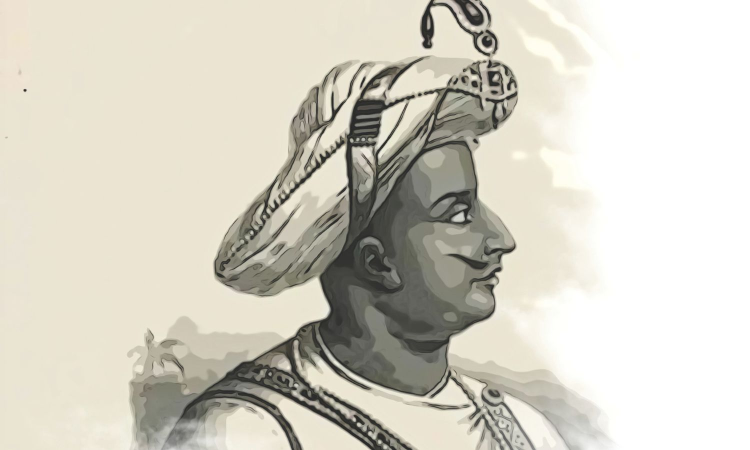Tipu Sultan: Tiger’s roar echoes loud in TN
An 84-page document recently released by the Tamil Nadu Archives department traces the meteoric rise of Tipu Sultan, also known as the Tiger of Mysore, and his fall on the battlefield over 200 years ago

Tipu Sultan
CHENNAI: Few figures in Indian history evoke as much admiration, controversy, and fascination as Tipu Sultan, the ruler of Mysore who stood as the fiercest opponent of British colonial expansion in South India.
Known as the Tiger of Mysore, Tipu’s military brilliance and political vision delayed the conquest of the present-day Tamil Nadu for decades. His role in the four Mysore Wars, extensively documented and recently released under the title, ‘The Four Mysore Wars and The Conquests of Tamil Nadu’, by the Tamil Nadu Archives department, demonstrates how his relentless struggle altered the course of Tamil history.
Rise of a leader
Tipu Sultan inherited both the ambition and adversaries of his father, Haider Ali. With the Mughal Empire collapsing and regional powers jostling for dominance, Mysore emerged as a formidable state in the late 18th century.
Haider Ali had already shaken the foundations of British supremacy in the Carnatic, and Tipu extended this legacy with sharper resolve. Archival material from the North Arcot Manual (1881) records stated that “the British had to wage four major wars with Haider and his equally brave son Tipu to establish their supremacy in the Carnatic.” This recognition underlines that Tamil Nadu’s conquest was not a swift annexation, but a prolonged contest shaped by Tipu’s resistance.
Haider Ali
Although the First Mysore War (1767–69) unfolded under Haider Ali, Tipu, still a young commander, played his part in campaigns that reached deep into Tamil territory. By the end of the war, Haider’s march to Madras and the humiliating Treaty of Madras proved that the British had underestimated Mysore’s power. This set the stage for Tipu’s own rise.
The Second Mysore War (1780–84) marked Tipu’s emergence as a decisive leader. When the British reneged on their earlier treaty obligations, Haider launched massive raids into the Carnatic, and Tipu, then in his 20s, commanded critical operations.
Archival sources describe how his cavalry stormed across Arcot, Vellore, and Kancheepuram, striking at the very heart of British strongholds. His campaigns culminated in the Treaty of Mangalore (1784), which, according to the Tamil Nadu Archives, was “one of the rare treaties where the British signed as equals with an Indian power.”
For the people of Tamil Nadu, this war revealed Tipu as more than a Mysorean monarch—he was the last formidable shield against unchecked colonial expansion.
The Third Mysore War (1790–92) tested Tipu’s resolve. His attack on Travancore, a British ally, triggered a massive counter-offensive led by Lord Cornwallis.
Despite Tipu’s valiant defense, he was forced to sign the Treaty of Seringapatam (1792), surrendering almost half of his kingdom. This treaty directly affected Tamil Nadu.
The British gained control over Dindigul, Coimbatore, and parts of Salem, crucial territories that opened Tamil lands to deeper colonial penetration. Yet, as the Gazetteers note, “The loss of one-half of his territories had not humbled Tipu’s pride. He still retained ample means to improve his position.” His determination set the stage for one last confrontation.
Tipu’s final stand
By 1799, Governor-General Lord Wellesley had resolved to end Tipu’s power once and for all. A coalition of the British, the Marathas, and the Nizam advanced on Mysore.
The Tamil Nadu Archives preserve vivid accounts of these battles: “Tipu’s horse harassed the advancing columns, his artillery thundered from Seringapatam’s walls, and he refused all offers of surrender”.
On May 4, 1799, during the storming of Seringapatam, Tipu died fighting near the Water Gate of his capital. His body was later discovered among heaps of slain soldiers.
British officers, including General Baird and Colonel Arthur Wellesley (later the Duke of Wellington), led the final assault.
Tipu’s campaigns were not confined to Mysore alone. The Tamil Nadu landscape itself became the theatre of his battles, with forts and towns falling, changing hands, and leaving scars that shaped colonial conquest.
Krishnagiri fort, perched on a rocky hill, was besieged during the First Anglo-Mysore War in 1768 and briefly fell to the British.
For Tipu, Krishnagiri was a gateway to the Tamil plains. Its passes allowed Mysorean forces to strike deep into the Carnatic, threatening British garrisons. Archival maps and battle reports preserved in the Tamil Nadu Archives illustrate how Krishnagiri remained a contested frontier throughout the wars.
Baramahal region, Dindigul, Arcot
The Baramahal region, including Salem, became one of the most hotly contested areas during Tipu’s campaigns. In 1768, British forces under Colonel Wood captured Salem, Attur, and Namakkal, only for Tipu to launch a lightning counter-offensive that regained these posts by December.
The Archives recount: “Within six weeks Haider had won back every post that had been taken, except Krishnagiri, Venkatagirikota and Kolar.” For Tipu, holding Salem was essential to controlling the Tamil plateau and denying the British a secure base.
The granite fort of Dindigul, on the edge of the Tamil plains, was a critical Mysorean bastion. During the Third Mysore War, Tipu was forced to cede Dindigul to the British, a turning point that allowed them to entrench deeper into Tamil territory.
Tamil Nadu Archives documents highlight the fort’s symbolic significance: once Dindigul fell, the southern flank of Tipu’s dominion was permanently breached.
Arcot, historically a prize for every power that sought control of the Carnatic, also witnessed Tipu’s campaigns. In 1780, during the Second Mysore War, Tipu’s forces laid siege to Arcot, threatening the very heart of British influence in Tamil Nadu.
Edmund Burke, in a speech later quoted in the Tamil Nadu Archives, described the devastation of the Carnatic under Tipu’s scorched-earth tactics: “A storm of universal fire blasted every field, consumed every house, destroyed every temple.”
Arcot became both a battlefield and a symbol — of Tipu’s determination to uproot British control from Tamil soil.
The British conquest of Baramahal in 1767; Cannon used to defend Seringapatam Fortress in 1799 during the Fourth Mysore War
Tamil resistance inspired
Even after these forts and towns fell to the British, the memory of Tipu’s defiance remained powerful. Leaders such as Veera Pandiya Kattabomman, the Maruthu Brothers, and Poolee Thevar drew strength from the Mysorean challenge to colonial authority.
The Tamil Nadu Archives emphasize that Tipu’s wars created a political and cultural atmosphere where local resistance found inspiration in his campaigns.
Tipu was not just a warrior; he was a visionary who understood the larger implications of colonial expansion. Archival notes record: “The main objective of Tipu Sultan was to liberate the land from foreign yoke. He took steps to form a confederacy of Indian rulers to prevent the establishment of British rule.”
His attempts to ally with the French and his diplomatic outreach to regional powers reflected his recognition that Tamil Nadu was the keystone in resisting British domination of South India.
The conquest of Tamil Nadu cannot be understood without acknowledging the decisive role of Tipu Sultan. For 30 years, his campaigns disrupted British advances, preserved indigenous power, and reminded colonizers that resistance in the south would not come easily.
His fall in 1799 marked the turning point when Tamil Nadu slipped firmly under British control. Yet his name—etched in both Tamil and Mysorean memory—remains synonymous with defiance.
The Tamil Nadu Archives sums it best: “Tipu was one of the greatest personalities who fought and died for the cause of his motherland.”
Two centuries later, the echoes of his roar as the Tiger of Mysore continue to resound across the Tamil landscape he fought so fiercely to protect.
Correcting the myth
In recent years, some have claimed that Tipu Sultan was killed not by the British but by two Vokkaliga chieftains – Uri Gowda and Nanje Gowda. However, this narrative finds no mention in any contemporary source, British dispatch, or archival record. The Tamil Nadu Archives, the Madras District Gazetteers, and detailed British accounts consistently state that Tipu died in combat against the British army at Seringapatam. The Gazetteer of Tamil Nadu (1986) affirms: “With the fall of Tipu, the only dreadful enemy of the British was removed from the scene forever.” His death was thus not a betrayal by local warriors, but a battlefield sacrifice in direct resistance to British conquest.



